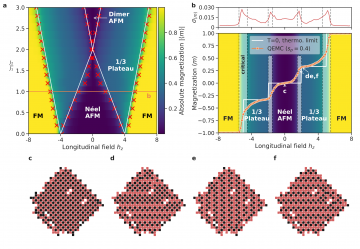
Achievement
An interdisciplinary, multi-institutional team led by ORNL composed of researchers from ORNL, UTK, Purdue University, and D-Wave, made strides towards realizing practical quantum simulation of material science problems by performing quantum simulation of a paradigmatic frustrated Ising model using a quantum processor. The work focused on simulating the frustrated Ising model on a Shastry-Sutherland lattice, which may have real material analogs in the rare-earth tetraboride family. The work developed a new symmetry-preserving embedding that mitigated common errors in quantum annealers, a new technique for determining boundary conditions that effectively mitigated finite-size effects, and simulation results exploring a phase transition between a ferromagnetic phase and fractional magnetization plateau by estimating critical properties at the phase boundary. The work demonstrated that quantum annealers with finite sizes and errors can be used to simulate properties of magnetic materials in the thermodynamic limit through appropriate error mitigation strategies. Finally the work makes a strong connection to elastic neutron scattering studies by calculating the static structure factor based on outputs from the quantum processor, promising future comparison to results on real materials.
Significance and Impact
This work provides a first example of how quantum computing can address modeling and simulation of materials and explicitly how these simulations can connect to DOE user facilities. Simulation of frustrated magnetism is critical to progressing understanding of quantum materials and this work demonstrates how a rapidly emerging class of quantum processors can be used to reliably simulate materials near the infinite limit even though the processor is prone to errors and has limited size. The demonstration indicates that these simulation tasks, which would normally require computing centers like the OLCF, could, in the future, be accomplished with significantly more compact and energy efficient quantum processors. Moreover, the work makes deep connections to neutron sciences that current ORNL facilities like SNS are capable of performing, promising a potential synergy between near-term quantum processors and state of the art material characterization via neutrons.
Research Details
- The Shastry-Sutherland lattice was embedded into the Chimera lattice of the DWave 2000Q using ferromagnetic spin chains in a manner which preserved the symmetry of the model Hamiltonian and respected the symmetry of the device hardware to minimize chain-breaking errors.
- Determination of the ground states for the Shastry-Sutherland Ising model was performed via the recently developed Quantum Evolution Monte Carlo chaining strategy, which performs quantum evolution/partial thermalization with a finite transverse field before performing annealing to obtain a classical ground state. This process is repeated with the output from the previous step (similar to a markov chain) to iteratively refine solutions and obtain estimates of the ground states. Experimental parameters were explored and optimized to obtain the lowest possible energy states.
- The phase diagram of the frustrated Shastry-Sutherland Ising model was reproduced with accurate determination of phase boundaries and recovery of all equilibrium magnetic phases, including the fractional magnetization plateau.
- The static structure factors at equilibrium and at a critical phase transition was calculated from the output of the quantum annealer, displaying critical behavior and previously unidentified, intermediate magnetic phases.
Overview
Team: Paul Kairys (UTK/ORNL), Andrew D. King (D-Wave), Isil Ozfidan (D-Wave), Kelly Boothby (D-Wave), Jack Raymond (D-Wave), Arnab Banerjee (Purdue University), Travis S. Humble (ORNL)
Citation and DOI: Paul Kairys, Andrew D. King, Isil Ozfidan, Kelly Boothby, Jack Raymond, Arnab Banerjee, and Travis S. Humble, “Simulating the Shastry-Sutherland Ising Model Using Quantum Annealing,” PRX Quantum 1, 020320 (2020).
Last Updated: February 19, 2021 - 2:52 pm